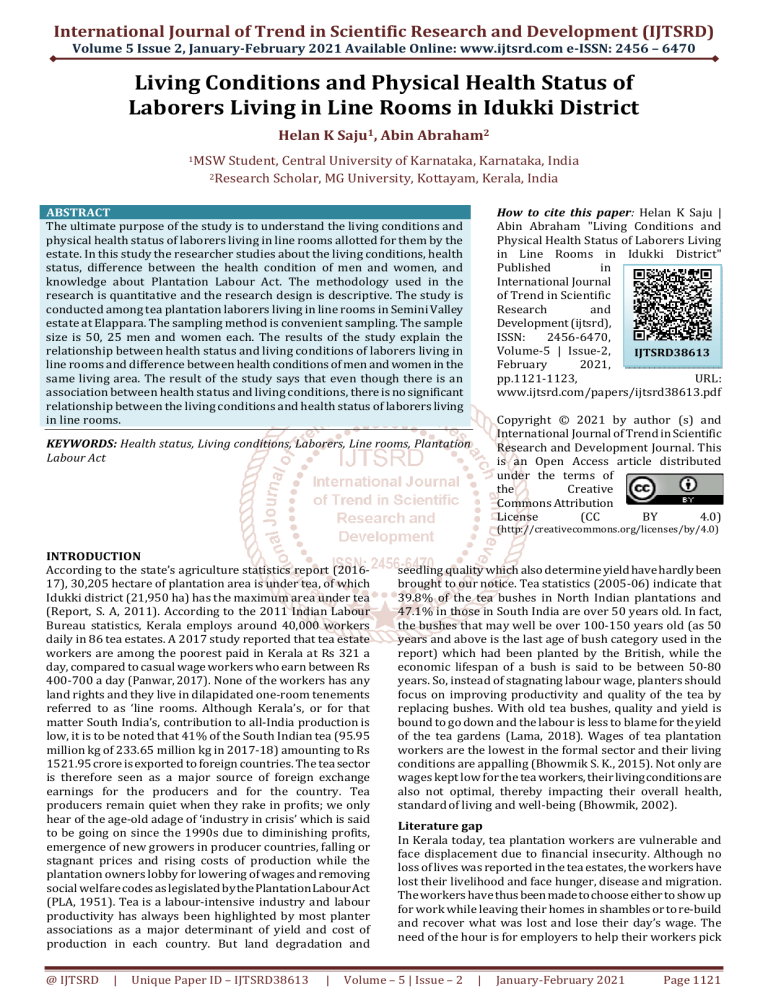
International Journal of Trend in Scientific Research and Development (IJTSRD)
Volume 5 Issue 2, January-February 2021 Available Online: www.ijtsrd.com e-ISSN: 2456 – 6470
Living Conditions and Physical Health Status of
Laborers Living in Line Rooms in Idukki District
Helan K Saju1, Abin Abraham2
1MSW
Student, Central University of Karnataka, Karnataka, India
2Research Scholar, MG University, Kottayam, Kerala, India
How to cite this paper: Helan K Saju |
Abin Abraham "Living Conditions and
Physical Health Status of Laborers Living
in Line Rooms in Idukki District"
Published
in
International Journal
of Trend in Scientific
Research
and
Development (ijtsrd),
ISSN:
2456-6470,
Volume-5 | Issue-2,
IJTSRD38613
February
2021,
pp.1121-1123,
URL:
www.ijtsrd.com/papers/ijtsrd38613.pdf
ABSTRACT
The ultimate purpose of the study is to understand the living conditions and
physical health status of laborers living in line rooms allotted for them by the
estate. In this study the researcher studies about the living conditions, health
status, difference between the health condition of men and women, and
knowledge about Plantation Labour Act. The methodology used in the
research is quantitative and the research design is descriptive. The study is
conducted among tea plantation laborers living in line rooms in Semini Valley
estate at Elappara. The sampling method is convenient sampling. The sample
size is 50, 25 men and women each. The results of the study explain the
relationship between health status and living conditions of laborers living in
line rooms and difference between health conditions of men and women in the
same living area. The result of the study says that even though there is an
association between health status and living conditions, there is no significant
relationship between the living conditions and health status of laborers living
in line rooms.
Copyright © 2021 by author (s) and
International Journal of Trend in Scientific
Research and Development Journal. This
is an Open Access article distributed
under the terms of
the
Creative
Commons Attribution
License
(CC
BY
4.0)
KEYWORDS: Health status, Living conditions, Laborers, Line rooms, Plantation
Labour Act
(http://creativecommons.org/licenses/by/4.0)
INTRODUCTION
According to the state’s agriculture statistics report (201617), 30,205 hectare of plantation area is under tea, of which
Idukki district (21,950 ha) has the maximum area under tea
(Report, S. A, 2011). According to the 2011 Indian Labour
Bureau statistics, Kerala employs around 40,000 workers
daily in 86 tea estates. A 2017 study reported that tea estate
workers are among the poorest paid in Kerala at Rs 321 a
day, compared to casual wage workers who earn between Rs
400-700 a day (Panwar, 2017). None of the workers has any
land rights and they live in dilapidated one-room tenements
referred to as ‘line rooms. Although Kerala’s, or for that
matter South India’s, contribution to all-India production is
low, it is to be noted that 41% of the South Indian tea (95.95
million kg of 233.65 million kg in 2017-18) amounting to Rs
1521.95 crore is exported to foreign countries. The tea sector
is therefore seen as a major source of foreign exchange
earnings for the producers and for the country. Tea
producers remain quiet when they rake in profits; we only
hear of the age-old adage of ‘industry in crisis’ which is said
to be going on since the 1990s due to diminishing profits,
emergence of new growers in producer countries, falling or
stagnant prices and rising costs of production while the
plantation owners lobby for lowering of wages and removing
social welfare codes as legislated by the Plantation Labour Act
(PLA, 1951). Tea is a labour-intensive industry and labour
productivity has always been highlighted by most planter
associations as a major determinant of yield and cost of
production in each country. But land degradation and
@ IJTSRD
|
Unique Paper ID – IJTSRD38613
|
seedling quality which also determine yield have hardly been
brought to our notice. Tea statistics (2005-06) indicate that
39.8% of the tea bushes in North Indian plantations and
47.1% in those in South India are over 50 years old. In fact,
the bushes that may well be over 100-150 years old (as 50
years and above is the last age of bush category used in the
report) which had been planted by the British, while the
economic lifespan of a bush is said to be between 50-80
years. So, instead of stagnating labour wage, planters should
focus on improving productivity and quality of the tea by
replacing bushes. With old tea bushes, quality and yield is
bound to go down and the labour is less to blame for the yield
of the tea gardens (Lama, 2018). Wages of tea plantation
workers are the lowest in the formal sector and their living
conditions are appalling (Bhowmik S. K., 2015). Not only are
wages kept low for the tea workers, their living conditions are
also not optimal, thereby impacting their overall health,
standard of living and well-being (Bhowmik, 2002).
Literature gap
In Kerala today, tea plantation workers are vulnerable and
face displacement due to financial insecurity. Although no
loss of lives was reported in the tea estates, the workers have
lost their livelihood and face hunger, disease and migration.
The workers have thus been made to choose either to show up
for work while leaving their homes in shambles or to re-build
and recover what was lost and lose their day’s wage. The
need of the hour is for employers to help their workers pick
Volume – 5 | Issue – 2
|
January-February 2021
Page 1121
International Journal of Trend in Scientific Research and Development (IJTSRD) @ www.ijtsrd.com eISSN: 2456-6470
up the broken pieces of their lives after rather than just look
at their losses, ignoring their years of accumulated profits
invested in diversifying their businesses, and abandon or
close the tea estates. Businesses should take opportunity to
revamp, restructure and empower the plantation models to
enable price competitiveness in an economically viable and
environmentally sustainable manner. They must develop
mechanisms and institutions to effectively keep track of
international market developments and be cautious about
price fluctuations instead of blindly running behind profits in
order to avoid facing disasters. They must invest in replantation and uprooting of old bushes while also developing
an efficient labour force by upgrading the workers’ skills and
education. Focus should be on providing amenities and wages
to avoid facing labour shortages and to maintain a healthy
and motivated labour force. Health is a state of complete
physical, mental and social well-being and not merely the
absence of disease or infirmity (WHO, 1946). So, it is
important to prove that if there is a dependency on physical
health status and living condition of plantation labourers in
tea estates.
Problem formulation
So, when consolidating in general, the researcher gets an idea
of the overall problem as follows:
The living conditions of labourers working in tea
plantation estates are appalling these days. The poor
infrastructure that these workers are having in their
living area makes the lives miserable for these large
numbers of people of our country
A number of strikes done by the workers bring forth the
miserable living conditions of the workers in the ‘line
rooms’ they live
Tea plantation industry is the largest in the formal
private sector with more than a thousand of workers.
Most of the plantation workers are migrant labourers
from other states who come to find a living
Workers are given houses inside the plantation so that
they can live with their families near the working area.
Whole the family will be working in the plantation and
their children will be studying in nearby schools. The
poor livelihood of the workers and their insecurities are
unheard in the social sector even in these 2019s
Poor facilitation leads to many problems among them,
mainly in health sector. Many people don’t know how to
reach proper medical care facilities
Achieve the sanitation facilities is much more a mission
that needs to be accomplished in the tea plantation
sector
Wages are kept low even though tea plantation industry
is the largest in the private sector. In that women and
men are not paid equally
No proper livelihood creates the havoc of nondevelopment for the workers decades after the
Plantation Labour Act has been came. There are laws
that govern and define about the living conditions that
the employers must provide in the living area of workers
but all those seem indifferent
Problem statement
Living Conditions and physical health status of labourers
living in line rooms. The living conditions of tea plantation
labourers are appalling. The employment they have doesn’t
@ IJTSRD
|
Unique Paper ID – IJTSRD38613
|
satisfy their basic and daily requirements. Health of an
individual is closely related to the environment of the person
he/she is related. Finding the relation between the health
status and living conditions will be a milestone in providing
their fundamental necessities by the employers. So, the
problem can be stated as researching on the relation between
the health status and living conditions of the labourers living
in line rooms.
Need of the study
The ‘Kerala model’ of development, underpinned by
education, health and robust public services has always set an
example and become a template for other states to follow.
The need of the hour is to provide better financial security to
workers to fulfill the goal of ‘decent work’, along with the
adoption of sustainable farming practices to protect the
delicate ecology of the region. Kerala has an opportunity to
re-build a strong plantation sector with the right set of
policies for the rest of the country to emulate. It must work
towards an all-inclusive model as the egalitarian quest of the
‘Kerala model’ of development was said to have been lost and
Scheduled Castes, tribes, fisher folk and plantation labourers
were termed as outliers in the ‘model’ and continued to
remain marginalized.
Objective
Many of the plantation estates have migrant labourers from
other states with a below poverty line measurement. None of
the workers has any land rights and they live in dilapidated
one- room tenements referred to as ‘line rooms’. The tea
plantation workers are at the lowest rung of the
organizational hierarchy, surviving at subsistence wages in
difficult working conditions doing delicate work of plucking
and manufacturing tea while still being considered as
unskilled workers. They are also highly dependent on
plantations for food, drinking water, housing, education and
healthcare. The enactment of the Plantation Labour Act
(1951) ensured that the management would provide these to
the workers while also safeguarding the rights of the
workers.
General Objective
To know the living conditions and physical health status of
plantation workers living in Idukki district.
Specific Objectives
1. To find out if the health status is related their living
conditions
2. To find out how men and women experiencing the same
living conditions and in that changes in their general
health conditions
3. Whether the workers living in line rooms have enough
knowledge and information about the Plantation Labour
Act (1951)
Methodology
The study is conducted among tea plantation laborers living
in line rooms in Semini Valley estate at Elappara. The
research method used is the quantitative method which
emphasizes objective measurements and statistical analysis of
data collected through questionnaire using computational
techniques. Descriptive design had been chosen for the same.
This research focuses on whether health status is affected by
the living conditions of the workers describing the conditions
or phenomenon present in the area of study. Semini Valley Tea
estate was selected as the universe of the research. Typically,
tea workers live on tea plantations in “labour lines.” Men and
women living in line rooms that work in the tea plantation
Volume – 5 | Issue – 2
|
January-February 2021
Page 1122
International Journal of Trend in Scientific Research and Development (IJTSRD) @ www.ijtsrd.com eISSN: 2456-6470
were selected to be the samples of the research. Sampling
method used is convenient sampling. This research is done
among the tea plantation labourers also to know whether the
plantation labourers have enough knowledge about the
policies available for them. The line rooms are given by the
plantation authority for their laborers to live and work in the
plantation. Workers are ready to leave the estate because of
poor housing quality and limited facilities. Most workers are
from neighboring villages of Tamil Nadu and speak Tamil.
This study followed all the ethical considerations and the data
was analyzed by using the SPSS software. The study period
was one year.
Analysis and discussion
This part is explained with the specific objectives of the study.
To find out if the health status is related their living
conditions
Even though they didn’t much care about their health
conditions, their living conditions haven’t affected their health
status. It shows that health status has an association with
living conditions found using chi-square test. Health status
and living conditions are negatively correlated to each other
tested using correlation.
To find out how men and women experiencing the
same living conditions and in that changes in their
general health conditions
The difference between health status of men and women are
tested using Independent Sample T-test. In the statistical test,
the hypothesis is that there is no significant difference
between specified populations.
Whether the workers living in line rooms have
enough knowledge and information about the
Plantation Labour Act (1951)
Majority of the laborers have poor knowledge about the
Plantation Labour Act and people have deficient knowledge
about the facilities and provisions provided for them in the
Act. Even 64% of the total sample didn’t hear about the Act.
Any authorities from the estate or government give no
information about PLA Act. Many people don’t know how to
reach proper medical care facilities.
Discussion and conclusion
This study is dealing about the living conditions and physical
health status of laborers living in line rooms. Lack of access to
safe drinking water, lack of toilet and bathroom facilities,
@ IJTSRD
|
Unique Paper ID – IJTSRD38613
|
overcrowding, lack of waste management system, lack of
proper garbage disposal areas are always a problem to
laborers living in one room tenements. Together it creates a
total of poor living conditions and makes the life of laborers
miserable. Insecure residential status, poor housing quality,
poor infrastructure is not just mere newspaper reports. Most
of the plantation workers are migrant laborers from other
states who come to find a living. Workers are given houses
inside the plantation so that they can live with their families
near the working area. Whole the family will be working in the
plantation and their children will be studying in nearby
schools. The poor livelihood of the workers and their
insecurities are unheard in the social sector even in these
2019s. The ‘Kerala model’ of development, underpinned by
education, health and robust public services, has always set an
example and become a template for other states to follow.
Plantation laborers was termed as outliers in the ‘model’ and
continued to remain marginalized. Assessing the effects of
limited living conditions helps social workers to advocate and
efficiently implement schemes for line room laborers in tea
estates. This research can be further used for improving
practice, policy and program services for laborers living
mainly in plantation and line rooms.
References
[1] Act, Plantation. Labour. (1951). PLA Act
[2]
Bhowmik, S. (2002). Productivity and Labor Standards in
tea plantation Sector in India. Labor and Social Issues in
South Asia: role of social dialogue
[3]
Bhowmik, S. K. (2015). Living Conditions of Tea plantation
Workers. Economic and Political Weekly
[4]
Bhowmik, S. K. (2015). Living Conditions of Tea
plantation Workers. WIEGO
[5]
Lama, S. D. (2018). After the floods, a way Forward for
Kerala's Tea Plantation Sector. The Wire. linehouse.
(2019). Line house.www.gramho.com.
[6]
Panwar, T. (2017). Living Conditions of Tea Plantation
Workers. International Journal of Advance Research and
Development
[7]
Report, S. A. (2011). Agricultural Report
[8]
WHO, P. t. (1946). International Health Conference.
Official Records of WHO
Volume – 5 | Issue – 2
|
January-February 2021
Page 1123





